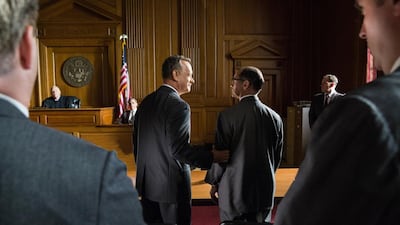Director: Steven Spielberg
Starring: Tom Hanks, Mark Rylance, Alan Alda
Four stars
In Hollywood, there’s no substitute for a good story — and few filmmakers know that better than Steven Spielberg.
The master of multiplexes certainly found a fantastic tale for his 31st feature. Bridge of Spies offers a true-life account of James B Donovan, an American lawyer who found himself embroiled in a Cold War hostage negotiation.
To help bring this unlikely hero to life, Spielberg has turned for a fourth time to Tom Hanks, who offers a fluid, studied account of an American everyman dropped squarely in the tumult of history. What remarkable things can happen when an ordinary guy is placed in a remarkable situation.
We meet Donovan in 1957, when he reluctantly agrees to defend captured Soviet spy "Colonel" Rudolf Abel (enigmatically played by Wolf Hall's Mark Rylance). The West wants Abel to hang, but Hanks's cynical insurance expert fights unjust judicial prejudices in an attempt to save his client.
About halfway, the action shifts to Berlin in 1962, where Donovan was again called on, this time to negotiate the trade of Abel for a captured American pilot.
“We need to have the conversations our governments can’t,” his Soviet counterpart tells him, in one of a series of creepy encounters.
Despite a slight rush towards the resolution, the script is tonally measured and carefully paced. Co-writers Matt Charman (Suite Française) and the Coen Brothers walk a tight line, peppering proceedings with welcome humour that doesn't derail the gravity of what is at stake.
The mood of Cold War paranoia is viscerally conjured with intricate sets, suspicious shadows and grainy, wide exposures. Long-time Spielberg cinematographer Janusz Kaminski’s work is frequently postcard-worthy, particularly in depicting the fabled Glienicke Bridge — separating West Berlin and East Germany — from which the film takes its name.
We are shown the value afforded to one human life in a milieu where individual lives carry so little value. A gobsmacked Donovan watches as East German teenagers are gunned down trying to clamber over the Berlin Wall to a better life — a situation mirrored by naughty kids jumping fences in suburban America.
One of the most affecting moments comes as American schoolchildren silently watch an educational video depicting a nuclear attack in their backyard.
Spielberg’s output can be patchy — but make no mistake, this is definitely Spielberg near the top of his game.
As the credits roll, we’re told how, just a few months later, Donovan was employed by the United States government to negotiate the release of 1,113 soldiers captured by Cuba in the Bay of Pigs Invasion. He somehow wound up securing the freedom of about 8,000 more prisoners from Fidel Castro.
Now that sounds like another story worth telling.
• Bridge of Spies is out in cinemas on THursday, November 26
rgarratt@thenational.ae

